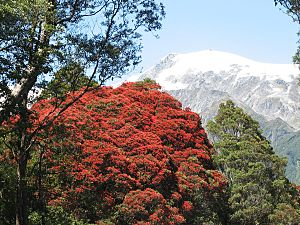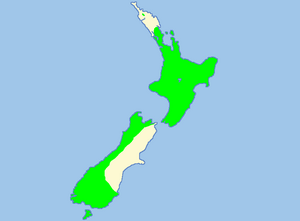Southern rātā facts for kids
Quick facts for kids Southern rātā |
|
|---|---|
 |
|
| Southern rātā near Franz Josef Glacier | |
| Scientific classification | |
| Genus: |
Metrosideros
|
| Species: |
umbellata
|
 |
|
| Distribution of M. umbellata in mainland New Zealand. Auckland Islands not shown. | |
| Synonyms | |
|
Metrosideros lucida (G. Forst) A. Rich |
|
The Metrosideros umbellata, also known as the southern rātā, is a special tree found only in New Zealand. It can grow very tall, sometimes over 15 meters (about 50 feet). Its trunk can be more than 1 meter (about 3 feet) wide. In summer, this tree bursts with many beautiful red flowers. Unlike its cousin, the northern rātā, this tree usually grows from the ground. It rarely grows on other plants.
Contents
What is Southern Rātā Like?
The southern rātā has bright red flowers. Each flower has long parts called stamens, which are about 2 centimeters (less than an inch) long. Sometimes, you might even see white or yellow flowers! These flowers usually bloom between December and February. The exact time depends on the weather where the tree is.
Its leaves are about 3 to 6 centimeters (1 to 2.5 inches) long and have sharp tips. The wood of the southern rātā is very hard and strong. The bark is rough and flaky. This rough bark is a great place for other plants to grow their roots. These plants are called epiphytes. Examples include Astelia plants and kiekie.
Southern rātā is very important for making honey, especially on the West Coast of the South Island. Birds like the kākā, tūī, and bellbird love to visit rātā trees. They come to drink the sweet nectar from the flowers.
Where Does Southern Rātā Grow?
This tree likes cooler places with lots of rain. It is very common along the west coast of the South Island. Here, its nectar is the main ingredient for a special local rātā honey. The southern rātā is the most common type of rātā tree in New Zealand.
You can find it in the North Island from about 36° south. It is more common in the western parts of the South Island. However, it is not found in many eastern areas. It grows a lot on Stewart Island (at 47°S). It also grows in the Auckland Islands, which is its southernmost home, just past 50°S.
Keeping Southern Rātā Safe
Even though the southern rātā is not considered in danger, it is quite rare in the North Island. In some places, it is threatened by possums. Possums like to eat the leaves and bark of the trees. In the Tararua mountain range, southern rātā trees seem to have been replaced. Now, there are mostly trees that are a mix of northern and southern rātā. These are called hybrids.
Project Crimson is a group that works to protect rātā trees. They also help protect the pōhutukawa tree, which is related to rātā.
Growing Southern Rātā
The southern rātā is a beautiful tree to plant in a garden. However, it can grow slowly unless it has the perfect conditions. It needs moist soil to grow well. It is easy to grow new trees from fresh seeds. You can also try to grow them from cuttings (small pieces of the tree). But these cuttings often do not grow roots easily.
Southern rātā is great for places near the coast. It can handle strong winds and salty air very well.
There are at least 16 different types, or cultivars, of southern rātā that people have grown. There are also types that are a mix of southern rātā and pōhutukawa. Some are even a mix of northern rātā and southern rātā. Here are some known types:
| Cultivar name | Year introduced | Flower colour | Introduced by | Notes |
|---|---|---|---|---|
| M. umbellata ‘Alba’ | mid-1980s | White/cream | Denis Hughes | Leaves are a paler lemon-green then standard plants. Sourced from Soaker Hill in the Catlins, South Otago. |
| M. umbellata ‘Christmas Dream’ | Late 1970s | Red | Denis Hughes | Sourced from Lake Manapouri. |
| M. umbellata ‘Denniston Yellow’ | 1995 | Sulphur Yellow | Deane Keir | Sourced from the Denniston Plateau. |
| M. umbellata ‘Fireball’ | 1993 | Bright crimson | Deane Keir | Sourced from the Stockton Plateau at a place called Burning Mine. |
| M. umbellata ‘Firecracker’ | 1995 | Deep red | Jeff Elliott | Sourced from Whanganui Inlet, North-West Nelson. |
| M. umbellata ‘Gold Beacon’ | - | Sulphur Yellow | Les Cleveland | Sourced from the Otira Gorge. |
| M. umbellata ‘Gold Nugget’ | 1992 | Red | Joe Cartman | Golden new leaves with thin red leaf margins. Sourced from side-shoot of M. umbellata ‘Harlequin’. Also sold as M. umbellata ‘Lownug’. |
| M. umbellata ‘Harlequin’ | md-1980s | Red | Joe Cartman | Variegated cultivar with yellow leaf margins. Sourced from Nugget Point. |
| M. umbellata ‘Kaka’ | late-1990s | Pink | Denis Hughes | Sourced from Kaka Point, Otago. |
| M. umbellata ‘Moonlight’ | 2001 | Red | Pattersons Nurseries | Reverse variegated cultivar. Sourced from side-shoot of M. umbellata ‘Gold Nugget’. Also sold as M. umbellata ‘Lowmoo’. |
| M. umbellata ‘Mt Augustus’ | Late-1970s | Red | Louise Salmond | Sourced from the Stockton Plateau at a place called Mt Augustus. |
| M. umbellata ‘Red Tips’ | Mid-1990s | Red | Les Cleveland | New leaves have a red tip. Sourced from an island in Lake Wanaka. |
| M. umbellata ‘St Nicholas’ | Late 1970s | Red | Denis Hughes | Sourced from Lake Manapouri. |
| M. umbellata ‘Scarlet Beacon’ | 2002 | Red | Les Cleveland | - |
| M. umbellata ‘Silver Beacon’ | Mid-1990s | Red | Les Cleveland | New leaves have a silvery tip. Sourced from an island in Lake Wanaka. |
| M. umbellata ‘Sparrow’s Hybrid’ | 1994 | Red | Mr Sparrow | Sourced from the banks of the Avon River in Christchurch, between Madras and Manchester Streets. Source material provided by Mr Sparrow, a customer of the nursery. Despite the name, this cultivar is not a hybrid. |
| ¤ Metrosideros ‘Cleveland Red’ | late-1990s | Scarlet | Les Cleveland | Deliberate interspecific hybrid. |
| ¤ Metrosideros ‘Maungapiko’ | 1985 | Bright crimson | Graeme Platt | Sourced from Maungapiko Track, Great Barrier Island. |
| ¤ Metrosideros ‘Rustic Beauty’ | 1985 | - | Les Cleveland | Deliberate interspecific hybrid. |
| ∞ Metrosideros ‘Sentinel Flame’ | 2007 | Bright red | Graeme Platt / Vibrant Earth nursery | Sourced from either Great Barrier Island or North-West Nelson. |
∞ This is a mix of southern rātā and northern rātā.
¤ This is a mix of southern rātā and pōhutukawa.
See also
 In Spanish: Árbol rata del sur para niños
In Spanish: Árbol rata del sur para niños


